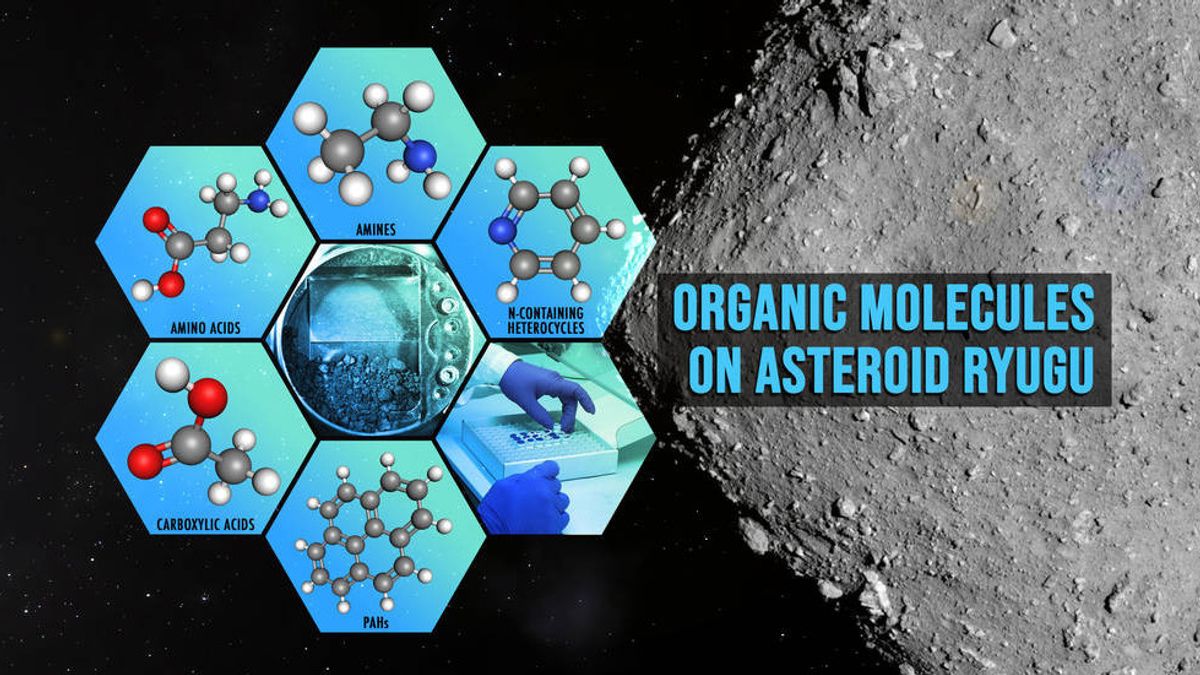JAKARTA - After conducting in-depth research, NASA revealed that asteroid Ryugu turns out to have organic compounds. This discovery supports theories where space rocks can contribute to the development of life on Earth.
The Japanese Aerospace Exploration Agency (JAXA) Hayabusa2 collected samples on February 22, 2019, and sent them to Earth on December 6, 2020.
The sample was extracted in Japan in July 2021 and analyzed in Goddard in the fall of 2021. The very small number of samples (30 milligrams or about 0.001 ounces) was allocated to the international soluble organic analysis team.
Then, samples were extracted (such as tea) in various solvents and analyzed in laboratories in Japan, Goddard, and Europe using various machines such as those in forensic laboratories.
As a result, the research team found the asteroid Ryugu was rich in the type of organic compound needed so that life could develop.
Organic molecules are a building block of all terrestrial life forms and consist of a variety of compounds. The molecules are made of carbon combined with hydrogen, oxygen, nitrogen, sulfur, and other atoms.
However, organic molecules can also be created by chemical reactions that do not involve life, supporting the hypothesis that chemical reactions in asteroids can create some elements of life.
Prebiotic chemistry seeks to find compounds and reactions that can lead to life, and among prebiotic organic materials found in the Ryugu asteroid sample there are several types of amino acids.
Certain amino acids are widely used by terrestrial life as components to build proteins. Proteins are essential for life because they are used to make enzymes that accelerate or regulate chemical reactions and to create structures from microscopic to large such as hair and muscles.
The samples also contain many organic types formed with liquid water, including amina aliphatics, carboxylic acid, polycyclic aromatic hydrocarbons, and heterocyclic compounds containing nitrogen.
"Although the environment is hard caused by heating the Sun and ultraviolet sweeping, as well as the irradiation of cosmic rays in high vacuum conditions, the presence of prebiotic molecules on the surface of asteroids shows that the top surface grains of Ryugu have the potential to protect organic molecules," said researcher Hiroshi Naraoka from Kyushu University, Fukuoka, Japan.
Naraoka is the main author of this research published online February 23 in Science, as reported by NASA's official website, Monday, February 27.
These molecules can be transported throughout the solar system, potentially spreading as interplanetary dust particles after being removed from the top layer of the asteroid due to collisions or other causes, said Naraoka.
So far, Ryugu's amino acid yields are largely consistent with what has been seen in some types of carbon-rich meteorites (carbons) that have been exposed to the most water in space.
"However, the sugar and nucleobuses ( DNA and RNA components) that have been found in several carbon-rich meteorites have not been identified in samples returned from Ryugu," said NASA's co-author Daniel Glavin Goddard.
"There is a possibility this compound exists in the Ryugu asteroid but is below our analytic detection limit given the relatively small sample mass available for study," he added.
This study is the first organic analysis of a sample of asteroid Ryugu, and the sample will be studied over the years.
"We will make direct comparisons of samples from Ryugu and samples from asteroid Bennu during NASA's OSIRIS-REx mission to return them to Earth in 2023," Dworkin said.
"OSIRIS-REx is expected to return more mass samples from Bennu and will provide another important opportunity to search for traces of life's organic building blocks in carbon-rich asteroids," he concluded.
The English, Chinese, Japanese, Arabic, and French versions are automatically generated by the AI. So there may still be inaccuracies in translating, please always see Indonesian as our main language. (system supported by DigitalSiber.id)








